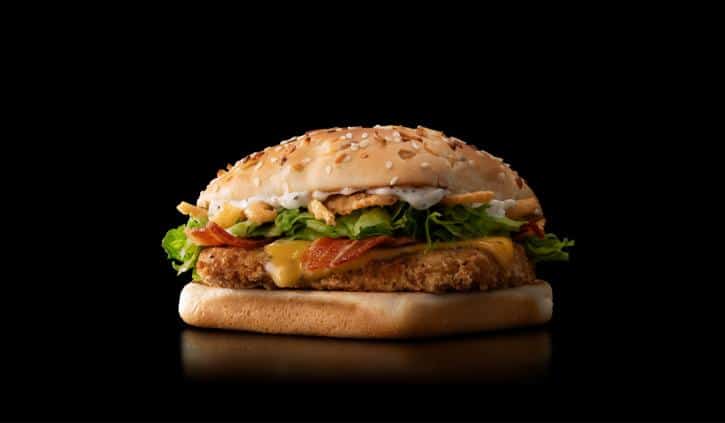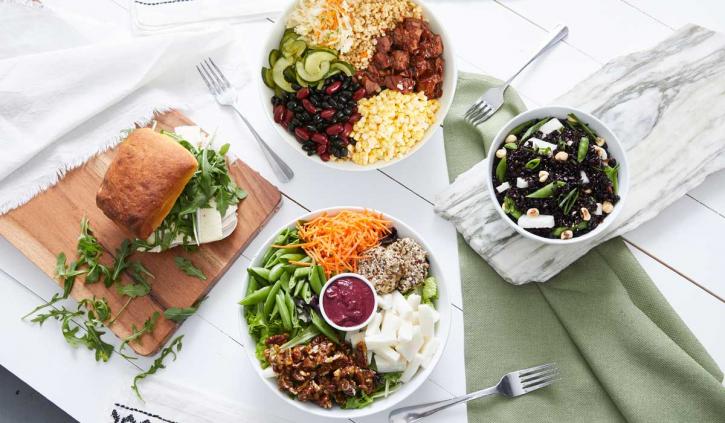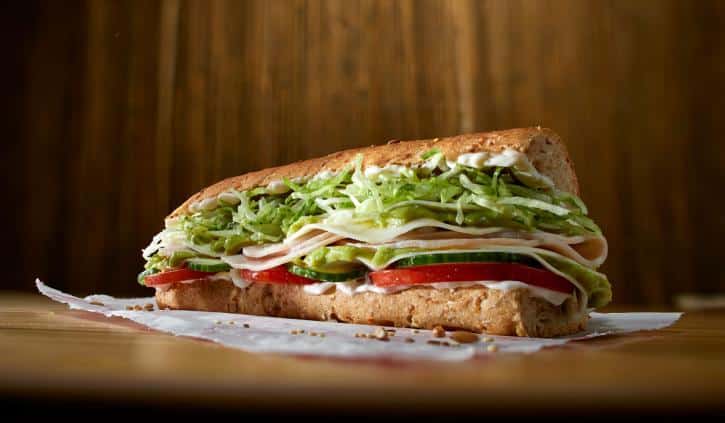












A New Year is dawning, and that means all sorts of resolutions and predictions come with it. The quick-service restaurant world has recently seen a wealth of changes with culinary diversification, menu optimization, and technological innovation leading the way. How will this all play out? QSR spoke to some fast food and casual insiders about what we can expect to see in 2020.
MORE LTOs WILL BE GOING GLOBAL …
If you have ever traveled outside of the U.S. and visited a popular American chain abroad, you know they sometimes have offerings that are catering to the local clientele there. Now some of those menu offerings may make their way to these shores as limited time offerings.
“Look at what McDonald’s does,” says Liz Moskow, principal at Bread and Circus Consulting. “I can’t go a day on my Facebook or Instagram feed without seeing what McDonald’s is doing all over the world in terms of menu innovation, whether it was that squid ink black bun in Japan in the past or the Stroopwafel McFlurry and the Tomato Mozzarella Chicken Sandwich.”
READ MORE: Could the key be global spices?
“I think they’re starting to bring those to the U.S. as limited time offers, bringing in that global vision of food with products they’ve already tested abroad. That’s a double innovation [with] that exotic LTO halo. I think we’ll be seeing that more beyond McDonald’s. They’ll leverage that as an exciting, limited time offer, and then if it goes well, maybe they’ll eventually bring it into their regular menu.”
WHILE GLOBAL OFFERINGS WILL ALSO GROW DOMESTICALLY
There is clearly a growing craving for different tastes, as hinted in the possibility of fast-food imports. But that will go deeper with some companies.
“Almost a quarter of Gen Z was born to immigrant parents,” says Leah Cotterman, director, Strategy & Insights at WD Partners. “You’ve got that youngest generation that’s used to being exposed to really diverse flavors, and what that’s creating is both ends of the spectrum coming together to create a halo of diners wanting more diverse menu options. If you’ve got people wanting a more experiential environment, and [others wanting] more diverse flavors, those two things come together to create this new spirit of food, adventure, and discovery.”
PLANT-BASED OFFERINGS WILL CONTINUE TO GROW
Vegetarianism and veganism are on the rise. Witness the gradual ascendancy of the Impossible Burger. But there are different reasons why such offerings will become more prevalent.
“While the overall demand for plant-based foods remains relatively low, we will continue to see restaurants jump on this bandwagon—either due to health and sustainability reasons, or because it is simply something ‘new’ to talk about,” says Dwayne Chambers, Checkers & Rally’s chief marketing officer.
READ MORE: Plant based takes Burger King to new heights
For many restaurants, plant-based offerings will be attractive from a health perspective and additionally for some, better for the environment. “The meat consumption is going to continue to go down,” Cotterman adds. “The plant-based needs are going to continue to go up. The organic is going to continue to go up. People are going to continue to be aware of their sugar, fat, and salt intake and customize to work around that. But it doesn’t mean that indulgence is going to go away. We certainly know that [with] younger generations, when you’re ready to cheat, go big or go home. That’s why we know that the Insta-culture is about the over the top indulgences, which I think is a place that [quick-service restaurants] can really win.”
SUSTAINABILITY WILL BE SOLD AS A NECESSITY
“If people don’t get into sustainability, we’ve got to figure out how to do this in a way that’s low impact to the environment, and how we are going to incorporate reusable containers and that sort of thing in a way that doesn’t mess up our speed of service,” Cotterman says. “That whole theme around impact and helpfulness and nutrition and sustainability is wrapped up not just in the procurement and the menu development, but just as much in delivering the service in a way that is as fast as people have grown to expect it.”
READ MORE: McDonald’s is turning coffee waste into car parts?
Moskow sees an expansion of sustainability incentives beyond just ditching plastic straws, such as supply chain changes, omitting plastic overall, and incentivizing reusable containers. “I think throughout [quick service] we might start seeing, beyond bring your own cup to Starbucks, bring your own cup for soda or something like that as opposed to all of this throw away plastic and packaging,” she says.
EXECUTION BEATS INNOVATION
“I think this is a year for people to execute,” says Andrew Wiederhorn, president, CEO, and founder of FAT Brands. “There’s a lot of product innovation and a lot of technology that’s come out, and at our level we’re really focused on executing all of our initiatives at our brands, a lot of CapEx initiatives. There will still be some product innovation on these ghost kitchens and virtual restaurants. We’ll see if they work. We have done franchise development on the ghost kitchen side. The verdict is still out on how successful we’ll be.” In other words, there are plenty of new ideas, but it will come down to operations, not simple brainstorming, to produce tangible results.
THIRD-PARTY DELIVERY WILL BECOME MORE CUSTOMER FRIENDLY
Many things can go wrong with third-party delivery, which is not always worth the cost of implementation. “Nor the most successful or great for rep brand reputation when stuff arrives cold, not crispy, or soggy,” Moskow says. “You can’t control it. There’s been a lot of talk about tamper-proof things so that the Uber Eats driver can’t get in there and snag a couple of French fries.” Plus packaging that can maintain heated items properly. “Food safety in general, deliberately being a whole new frontier in terms of figuring out how to deliver the end product the way it needs to appear to the consumer. They’re struggling. I don’t know that there is a perfect way.”
READ MORE: In-house versus third-party delivery: The debate rages on
Moskow adds that some companies might develop a smaller, limited menu of delivery only offerings that they can guarantee will arrive without issue, or if they arrive cold can be reheated “and still resemble the final product in the store,” she says.
VOICE-OPERATED KIOSKS WILL PREFACE FACIAL-RECOGNITION KIOSKS
While Moskow sees facial recognition kiosks in the future, she and others view voice recognition as the predominant format for now. “I think the tech that’s going to be in the near term is voice,” she says.
READ MORE: What about menuboards?
“But I do think further off you’re going to have the facial recognition. ‘We recognize you and you like big Macs. You want your special sauce on the side.’ It’s like that optimization play for that virtual ordering: how can we better customize it? Rather than just having to push a bunch of buttons, it’s already auto populated with your preferences.”
NOT EVERYONE WILL EMBRACE KIOSKS. SOME CHAINS STILL PREFER A MORE HUMAN TOUCH
“Kiosk ordering is relevant in the [quick-service restaurant] space and a little bit relevant in the fast-casual space,” Wiederhorn says. “We’ve preferred to see the technology on the delivery side of things. Delivery apps have just gotten better and better. They’ve taken all the technology out of the restaurants’ hands so we don’t have to deal with that. We have preferred to see an increase in volume from delivery rather than going to kiosks to cut labor costs. We’re growing top line sales instead of trying to cut labor costs. We want the guest to have interaction with our cashiers and talk about what they want and customize their burgers. I think there’s a continued push for better service and better relationships with the service staff. I don’t think it’s all automation where people want to go to the kiosk and don’t want to interact with somebody.”
READ MORE: How to win with kiosks
“With regard to the kiosks, I see that as an intermediate step, growing pains between getting people to order primarily on their phones and interacting with a person at the counter,” says Rose Phillips, lead strategist for WD Partners. “I don’t really think kiosks are going to be around 15 years from now.”
THE LINES BETWEEN AM AND PM MENUS MAY BLUR
Moskow predicts we may witness “brunchification” in AM/PM menu crossover. “I think with that ‘put an egg on it’ philosophy and moving that breakfast into lunch, we’re going to start seeing some more of the lunch offerings at breakfast, like the Breakfast Burger,” she says.
READ MORE: Breakfast sandwiches take over quick service
“We’re given permission to do that now because we’re starting to see global umami flavors at breakfast, like the Jian Bing pancakes people are eating in China. People are starting to understand that breakfast doesn’t need to just be McGriddles. It could be savory, and it is beyond that egg sandwich. I think a burger at breakfast might be more permissible, especially if it has an egg on it. That’s a two-prong story there with the egg.”
MORE GHOST KITCHENS WILL MATERIALIZE
The rise of ghost kitchens—off-site cooking facilities that create food solely for online ordering and delivery—is coming. “We might start to see some of the bigger [quick-service restaurant] players have dedicated ghost kitchens with specific menus that aren’t necessarily available,” Moskow says. “They might have limited menu for delivery, but they might also have a different menu for delivery only that you can’t get in-store, that’s being made in an offsite satellite kitchen that is optimized for delivery.”
READ MORE: KItchen United CEO: Restaurants are missing the point with delivery fees
Ghost kitchens may become a source of controversy for urban hubs like Manhattan. A recent New York Times report pointed out how such sites could reduce solid job opportunities and hurt brick-and-mortar competitors who cannot operate as cheaply. Ghost kitchens would only benefit those who order from mobile apps, but if they become more financially beneficial for chains, they will keep proliferating.
MORE CHAIN CONSOLIDATION IS COMING
“We are close to a place where a few large companies own most of the restaurant concepts,” Chambers says. “Like trading cards, they will swap them around looking for the perfect combination of companies to maximize their efficiency and return. These companies will work to find the efficiencies of multiple brands will give them competitive advantages in innovation, purchasing, margins, promotions, and marketing/communications.”
Wiederhorn believes that a shake-up with smaller brands is inevitable. “We haven’t seen that change in the economy yet, and I think that’s going to be reflected at some point with some push back,” he says. “If the economy drops off, some of these smaller brands are going to be on the edge. I’m seeing that some of the smaller startup brands on the pizza side, I think there’s a lot of consolidation. There are a lot of 20- and 30-unit pizza brands for sale. I don’t know where that ends up.”
PROCURING QUALITY RECRUITS WILL REMAIN A PRIORITY
“As the fast-casual industry is a place that, according to CNBC, loses up to 130–150 percent of employees every year, keeping up with the demand of hiring good, quality employees is of the utmost importance,” says Daniel Lee, marketing manager for Flame Broiler.
READ MORE:
Why are good employees quitting restaurants?
Should you hire older workers?
“Using recruiting platforms such as ClearFit or Sentio enables franchisees to sift through the endless applications they receive so that they can actually hire the right people for their locations and build lasting relationships with their future employees. We are sure that this tool will become widely popular in 2020.”




